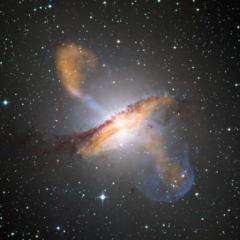June 3, 2013 report
Researchers suggest gas cloud could reveal black holes near center of Milky Way galaxy

(Phys.org) —A team of researchers from Columbia University has published a paper in Physical Review Letters in which they suggest that the movement of gas cloud G2 near the center of our galaxy may reveal previously hidden small black holes. They note also that observation of G2's movement might lead to direct evidence of the existence of intermediate size black holes.
G2, a massive cloud of gasses three times the size of Pluto's orbit (but just 3 times the mass of Earth) was discovered moving through our galaxy two years ago by researchers at the Max Planck Institute. After noting its projected path, the researchers at Columbia have found that it will likely pass through a region of space that is thought to harbor as many as 20,000 small black holes (a single massive black hole is believed to exist at the center of our galaxy.) They suggest that researchers here on Earth might be able to actually see the interaction between the gas cloud and any black holes that are encountered. As the gas cloud comes near a black hole, they believe some of the gas will begin to spiral as it's pulled in by its gravity. That, they say, should cause a lot of heat to be expelled and x-ray light to be emitted—enough to be observable using x-ray telescopes. They go so far as to estimate that researchers might be able to see evidence of as many as 16 interactions.
More exciting to some in the field, is the possibility that the movement of G2 through our galaxy may give direct evidence of what are known as intermediate sized black holes—believed by some to be several times the mass of our sun. To date, their existence is purely theoretical. If G2 comes across one, and interacts with it, the event could prove that they really do exist. They, like the many small black holes in the universe, are believed to reside near the center of the galaxy, which is where G2 is heading. The researchers estimate it will reach the best position for study this September, giving researchers plenty of time to prepare.
One unknown attribute of G2 could throw a wrench into the project however—the density of the gas cloud is not yet known. If it's not dense enough, any interactions with a black hole may not create enough light to be seen from Earth.
More information: Gas Cloud G2 Can Illuminate the Black Hole Population Near the Galactic Center, Phys. Rev. Lett. 110, 221102 (2013) prl.aps.org/abstract/PRL/v110/i22/e221102
Abstract
Galactic nuclei are expected to be densely populated with stellar- and intermediate-mass black holes. Exploring this population will have important consequences for the observation prospects of gravitational waves as well as understanding galactic evolution. The gas cloud G2 currently approaching Sgr A* provides an unprecedented opportunity to probe the black hole and neutron star population of the Galactic nucleus. We examine the possibility of a G2-cloud–black-hole encounter and its detectability with current x-ray satellites, such as Chandra and NuSTAR. We find that multiple encounters are likely to occur close to the pericenter, which may be detectable upon favorable circumstances. This opportunity provides an additional important science case for leading x-ray observatories to closely follow G2 on its way to the nucleus.
Journal information: Physical Review Letters
© 2013 Phys.org





















